An Urgent Need to Reconsider Restraint Practices in Elder Care Settings
Physical restraints are widely used in elder care to prevent falls, manage behavioral disturbances, and ensure safety. However, recent research underscores profound psychological and emotional impacts that these devices can inflict on older adults. This article explores the intricate web of consequences associated with restraint use, including its adverse effects on mental health, dignity, cognition, and overall quality of life, while highlighting ethical considerations, alternative strategies, and best practices to minimize harm.
Prevalence and Types of Restraints in Elder Care
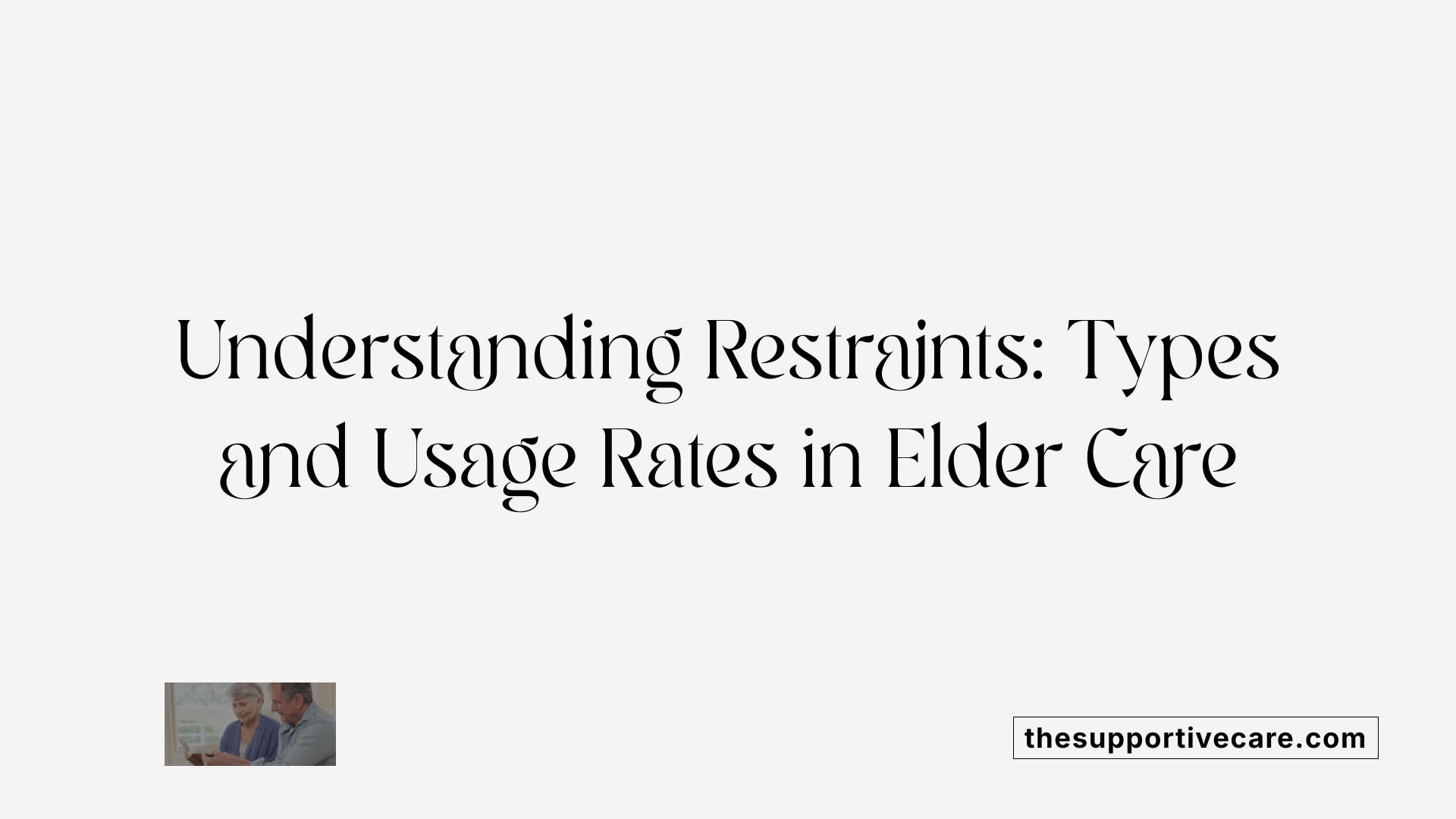
What are the types of physical restraints used in elder care?
Physical restraints are devices and equipment designed to limit or restrict an older person's movement to prevent harm or manage behavior. Commonly used types include vests, straps, limb ties, and wheelchair bars. Bedside rails are also frequently employed to prevent falls or to keep residents within their beds. These devices are attached near or to the body and are intended to control or restrict mobility, often as a last resort when other options have failed.
These restraints can be simple, like cloth ties or belts, or more complex systems such as special chairs with straps and bars. The use of restraint devices varies across care settings and individual patient needs, but all share the common goal of ensuring safety, albeit with potential physical and psychological risks.
What is the prevalence of restraint use among older persons?
Research shows that the use of physical restraints among older adults varies widely, reflecting differences in healthcare practices, legislation, and cultural norms. Reported usage rates span from as low as 4% to as high as 85%. This range depends heavily on factors such as the setting—home care, nursing homes, or hospitals—and the population's health status, particularly prevalence of cognitive impairments like dementia.
For example, in hospital settings, restraint rates can reach around 8%, with higher prevalences observed in nursing homes—sometimes exceeding 50%. The variation underscores the importance of organizational policies, staff training, and legal frameworks to guide restraint practices and minimize unnecessary use.
| Aspect | Range | Influencing Factors |
|---|---|---|
| Restraint prevalence in elder care | 4% - 85% | Care setting, resident health status, local legislation |
| Typical use in hospitals | Around 8% | Patient behavior, staffing levels |
| Restraint rates in nursing homes | Can be above 50% | Resident cognitive impairment, organizational policies |
Understanding the diversity in restraint use highlights the ongoing need for policies favoring restraint reduction, emphasizing person-centered care and the exploration of alternatives to ensure both safety and dignity for older adults.
Physical and Psychological Harms of Restraints
What are the risks and harms associated with physical restraints?
Physical restraints involve devices such as vests, straps, limb ties, wheelchair bars, and bedrails, attached to or near a person's body to limit movement. While sometimes used to prevent falls or manage agitation, their application carries significant health risks. Restraints can cause bruises, bedsores, and skin injuries. They may impair circulation, increasing the likelihood of blood clots or infections. Respiratory complications can occur if restraints compress the chest or neck, risking suffocation. Additionally, restraints can lead to urinary incontinence, constipation, undernutrition, and muscle atrophy. Severe physical injuries, including fractures, nerve damage, and even death from strangulation or falls, are documented.
Psychologically, restraint use can be traumatic. Older adults often experience feelings of shame, loss of dignity, anxiety, and depression. Moreover, being restrained can induce a sense of imprisonment, trigger fear, and undermine trust in caregivers. Such experiences may prolong emotional distress and hinder recovery.
How do restraints affect cognitive and mental health?
Restraints not only impact physical health but also significantly influence cognitive and emotional well-being. They can hasten cognitive decline, especially in individuals with dementia, by increasing stress and agitation. The trauma associated with restraint episodes can exacerbate confusion, anxiety, and feelings of helplessness. Longer-term, these effects may evolve into depression or post-traumatic stress disorder (PTSD). Residents with prior trauma or psychiatric conditions often find restraint episodes retraumatizing, deepening feelings of worthlessness and loss of autonomy. The psychological burden may also affect behavior, leading to increased aggression or withdrawal.
In sum, physical restraints present serious physical dangers and profound psychological impacts that can diminish the quality of life for older adults, highlighting the importance of alternative, person-centered care practices.
The Emotional and Psychological Toll on Elderly Residents
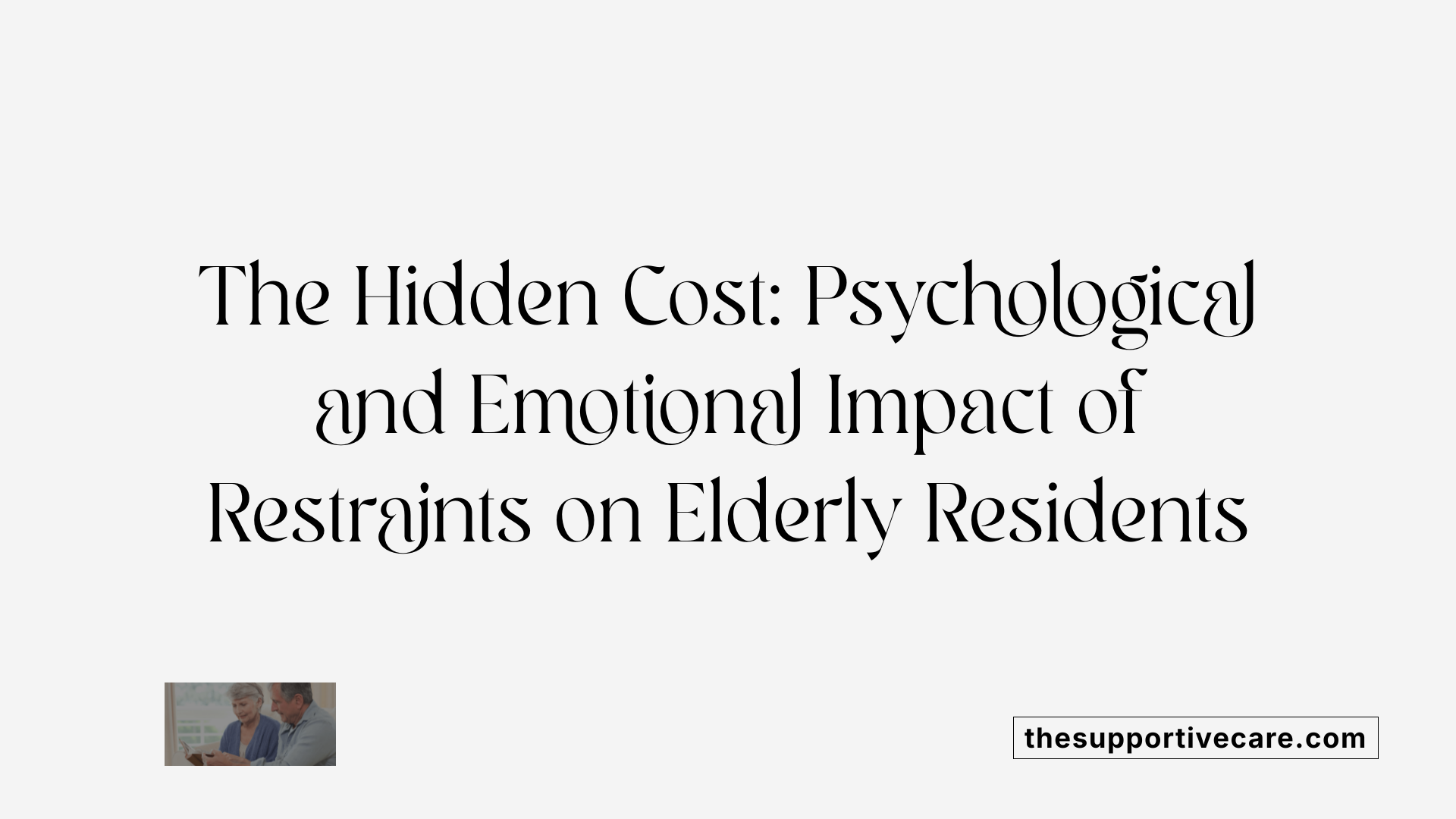
What are the psychological and emotional impacts of physical restraints?
Restraints can have profound effects on the mental health of older adults. Many residents report feelings of fear, helplessness, shame, and a loss of dignity when restrained. Being physically restricted often leads to emotional distress, with some experiencing long-term trauma, depression, and a decreased sense of self-worth. This is especially true when restraints are used without proper consent or when they are applied in a manner that lacks compassion. The experience of being restrained can evoke feelings of powerlessness, humiliation, and social isolation, impacting the resident's overall well-being.
What are the potential long-term psychological consequences?
The psychological repercussions can extend well beyond the immediate event. Long-lasting effects include the development of post-traumatic stress disorder (PTSD), anxiety, and chronic depression. Many residents may find it difficult to trust caregivers afterward and might become withdrawn or less willing to participate in social or rehabilitative activities. Persistent feelings of powerlessness and shame can negatively influence their mental health, leading to a poor quality of life. Recognizing these consequences underscores the importance of minimizing restraint use and focusing on respectful, person-centered care.
| Aspect | Impact | Additional Details |
|---|---|---|
| Emotional feelings | Fear, helplessness, shame | Often linked to loss of dignity and social isolation |
| Long-term effects | Trauma, depression | Can impair trust and participation in social activities |
| Psychological risks | Anxiety, PTSD | Can lead to ongoing mental health struggles and diminished self-esteem |
Ethical Considerations and Decision-Making in Restraint Use
What are the ethical considerations concerning the use of restraints on elderly residents?
Restraint use in elder care demands careful ethical reflection grounded in respect for human dignity, autonomy, and overall wellbeing. Generally, restraints should only be used after thorough assessments that consider the potential physical and psychological harms involved. Informed consent is essential, requiring clear communication with residents and their families about the risks, benefits, and alternatives.
Most ethical frameworks advocate that restraints be viewed as a last resort. This means exploring all less restrictive options first, such as environmental adjustments, increased supervision, or behavioral interventions. When restraints are deemed necessary, they must be individualized, proportionate to the risk, and constantly monitored and reevaluated to minimize harm. Upholding these principles helps preserve the personhood of older residents, balancing safety with respect and dignity.
What is crucial in developing personalized care plans to prevent restraints?
Creating effective, restraint-free care plans relies on comprehensive assessments carried out by a multidisciplinary team. This assessment should explore the resident's physical health, cognitive status, behavioral tendencies, and environmental factors contributing to perceived safety risks.
Involving residents and their families in planning fosters a sense of control and respects their preferences. Care plans should be tailored to the individual’s unique needs, incorporating preventive strategies such as engaging activities, environmental modifications, and staff training in communication techniques. Regular review of these plans ensures timely adjustments and sustained efforts to reduce dependence on restraints, promoting dignity and quality of life.
| Aspect | Approach | Additional Details |
|---|---|---|
| Assessment | Comprehensive and multidisciplinary | Includes physical, cognitive, behavioral, and environmental factors |
| Involvement | Resident and family participation | Enhances personal relevance and acceptance |
| Strategies | Preventive measures and staff training | Emphasizes non-restrictive interventions |
| Monitoring | Regular review and adjustment | Ensures ongoing safety and respect |
Through such personalized, ethically grounded approaches, elder care can uphold the rights and dignity of residents while minimizing restraint use.
Strategies and Best Practices to Minimize Psychological Harm
What strategies and methods can reduce psychological harm from restraints?
Implementing trauma-informed, person-centered care approaches is crucial in reducing the reliance on physical restraints and the associated psychological harm. These strategies emphasize respecting the individual's dignity, autonomy, and emotional needs.
Staff training is fundamental. Educating caregivers and healthcare staff about de-escalation techniques, environmental modifications, and personalized interventions helps diffuse challenging behaviors effectively and compassionately.
Organizational culture also plays a significant role. Establishing policies that prioritize restraint-free care, along with multidisciplinary team discussions, fosters a supportive environment where alternatives are explored first.
Involving families in care planning ensures that personal histories and preferences are respected, further enhancing trust and reducing distress.
Are there effective alternatives to restraints?
Absolutely. Several non-restrictive measures can manage risks while safeguarding emotional and physical wellbeing.
Environmental adjustments, such as improved lighting, clear signage, and safe layouts, can reduce confusion and agitation.
Therapeutic activities and engagement, including music, reminiscence therapy, or physical exercise, help in calming residents and addressing unmet needs.
Enhanced supervision, using technology like cameras or alarm systems, can serve as a safer alternative to restraints.
Behavioral interventions tailored to individual triggers and needs, supported by regular assessments, further diminish the need for physical restrictions.
Overall, adopting these strategies within a comprehensive policy framework promotes safer, more dignified care environments and minimizes psychological trauma linked to restraint use.
Impact of Restraints on Cognition and Long-Term Mental Health
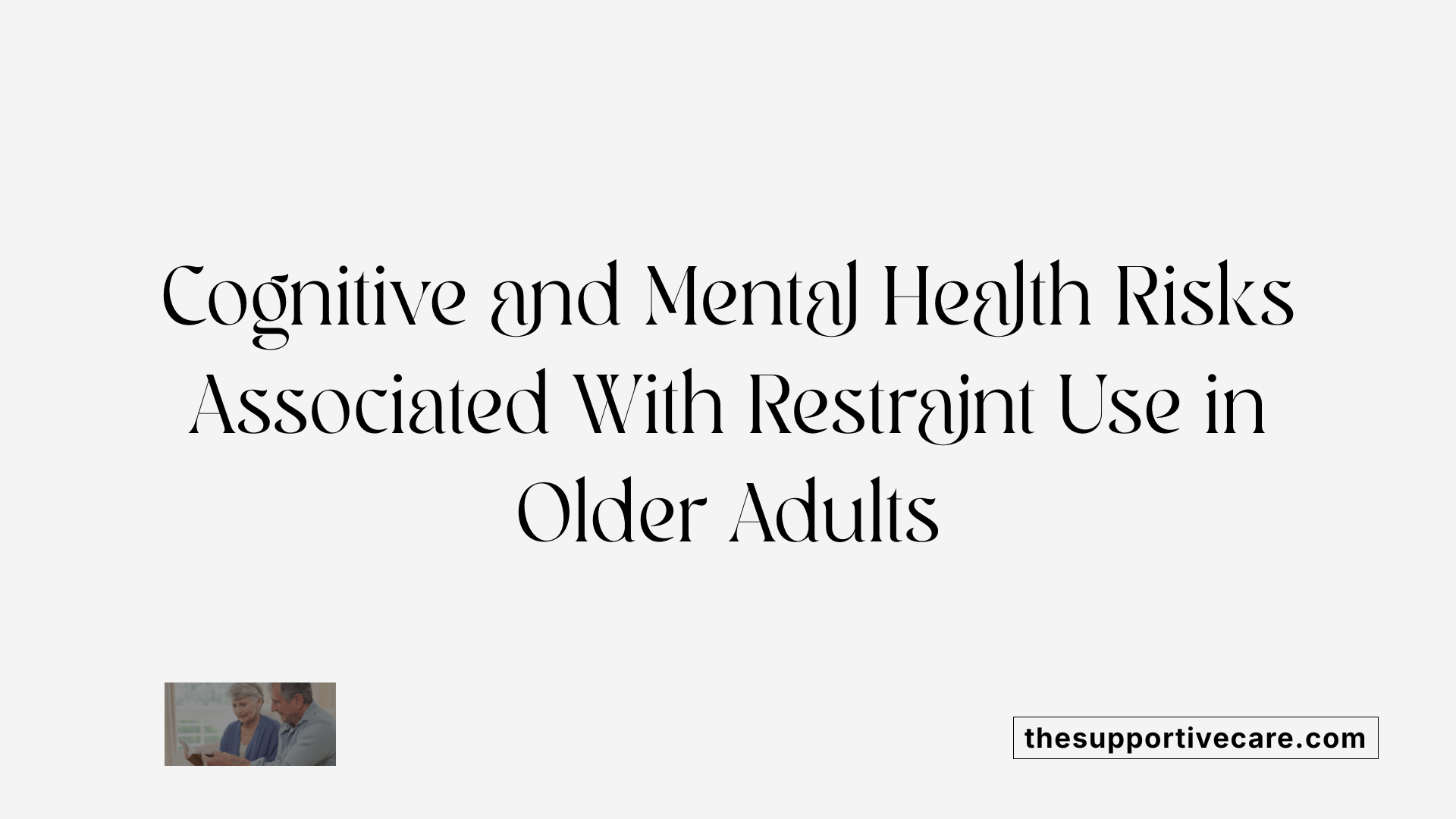
How do restraints impact cognition and mental health?
Physical restraints can significantly influence the emotional and mental well-being of older adults. When restrained, many individuals experience feelings of fear, humiliation, and low self-esteem. These emotional responses can trigger heightened anxiety and confusion, especially in those with already compromised cognitive functions.
Over time, the psychological distress associated with restraint use may contribute to accelerated cognitive decline. Prolonged or repeated restraint can foster social withdrawal, depression, and delirium, further impairing mental health. The experience of being restrained can also re-traumatize individuals with past trauma, such as military service or previous abuse, exacerbating feelings of helplessness.
Research emphasizes that minimizing restraint use is crucial not only for physical health but also for preserving mental acuity and emotional stability. Alternative care strategies should focus on communication, engagement, and environmental adjustments to reduce reliance on restrictive devices.
In essence, restraint practices carry substantial risks for cognitive and mental deterioration, underscoring the importance of person-centered, restraint-free care approaches that promote dignity and psychological safety for older adults.
Effectiveness and Ethical Concerns of Restraint Legislation and Policies
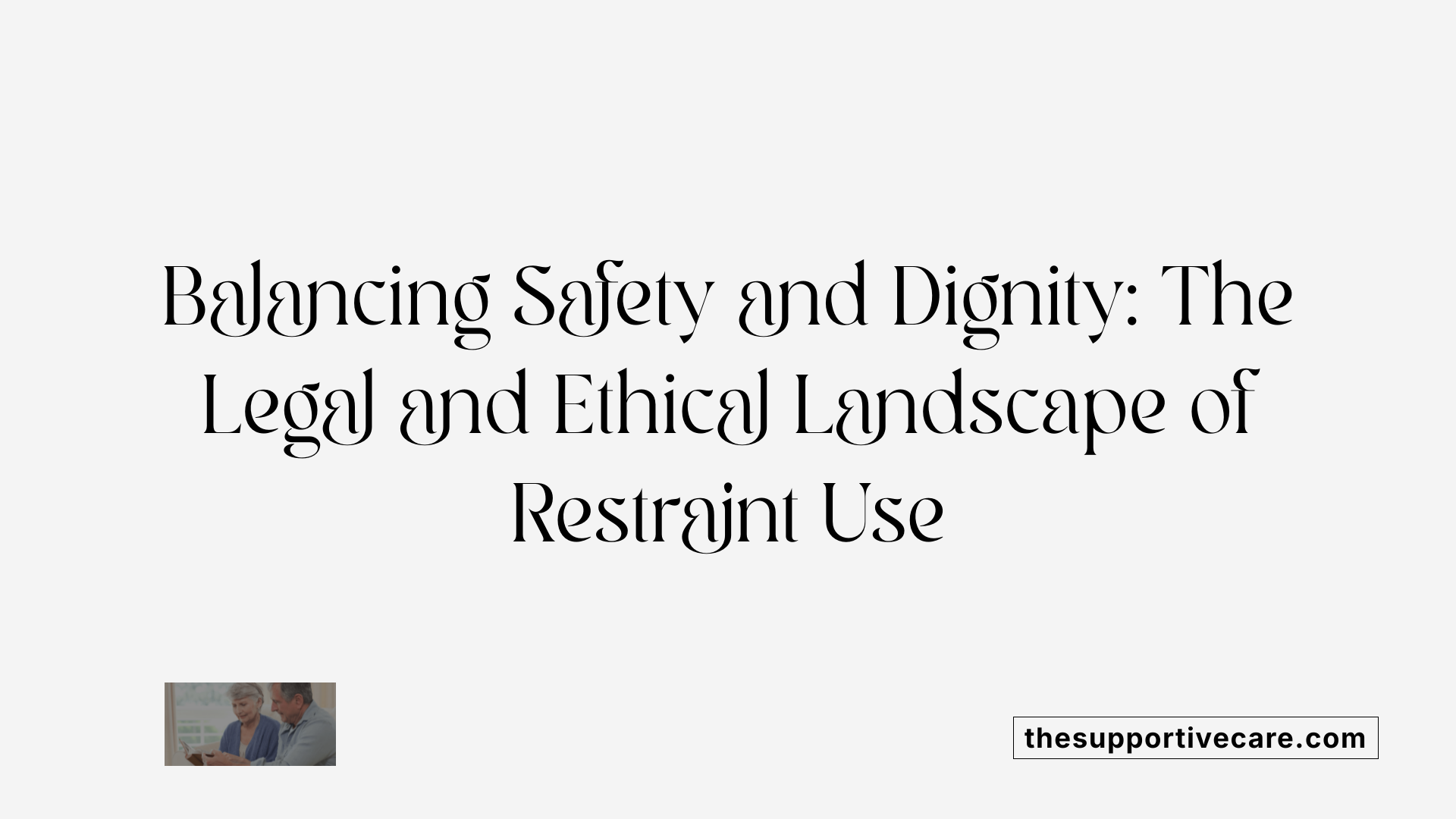
What are the ethical and legal considerations around restraint laws?
Restraint laws are designed to protect the dignity and rights of older persons by setting strict regulations on restraint use. These laws emphasize informed consent—meaning that patients or their legal representatives must be fully aware of the reasons, risks, and alternatives before restraints are applied. Regular review and timely renewal of any restraint are also mandated to ensure ongoing necessity. Legislation generally frames restraint as a last resort, only permissible when the risk of serious harm outweighs the potential harms caused by restraint.
Across different jurisdictions, such as Belgium and the European Convention on Human Rights, there are clear legal guidelines emphasizing the respect for human dignity and autonomy. Restraints without proper authorization or beyond the legally set limits are considered unlawful. Despite these legal frameworks, actual practice often falls short, with some staff feeling that restraints enhance safety and control, leading to inconsistent application.
Institutional policies play a crucial role in bridging the gap between law and practice. Effective policies involve clear protocols for assessing the necessity of restraints, detailed documentation, and regular staff training. Such training aims to increase awareness of ethical principles, improve knowledge of alternatives, and foster a culture that prioritizes restraint-free care whenever possible.
In summary, while legislation aims to uphold ethical standards and protect vulnerable individuals, ongoing education, diligent policy enforcement, and organizational commitment are essential to ensure these laws translate into safer and more respectful care practices.
Conclusion: Towards Restraint-Free Elder Care
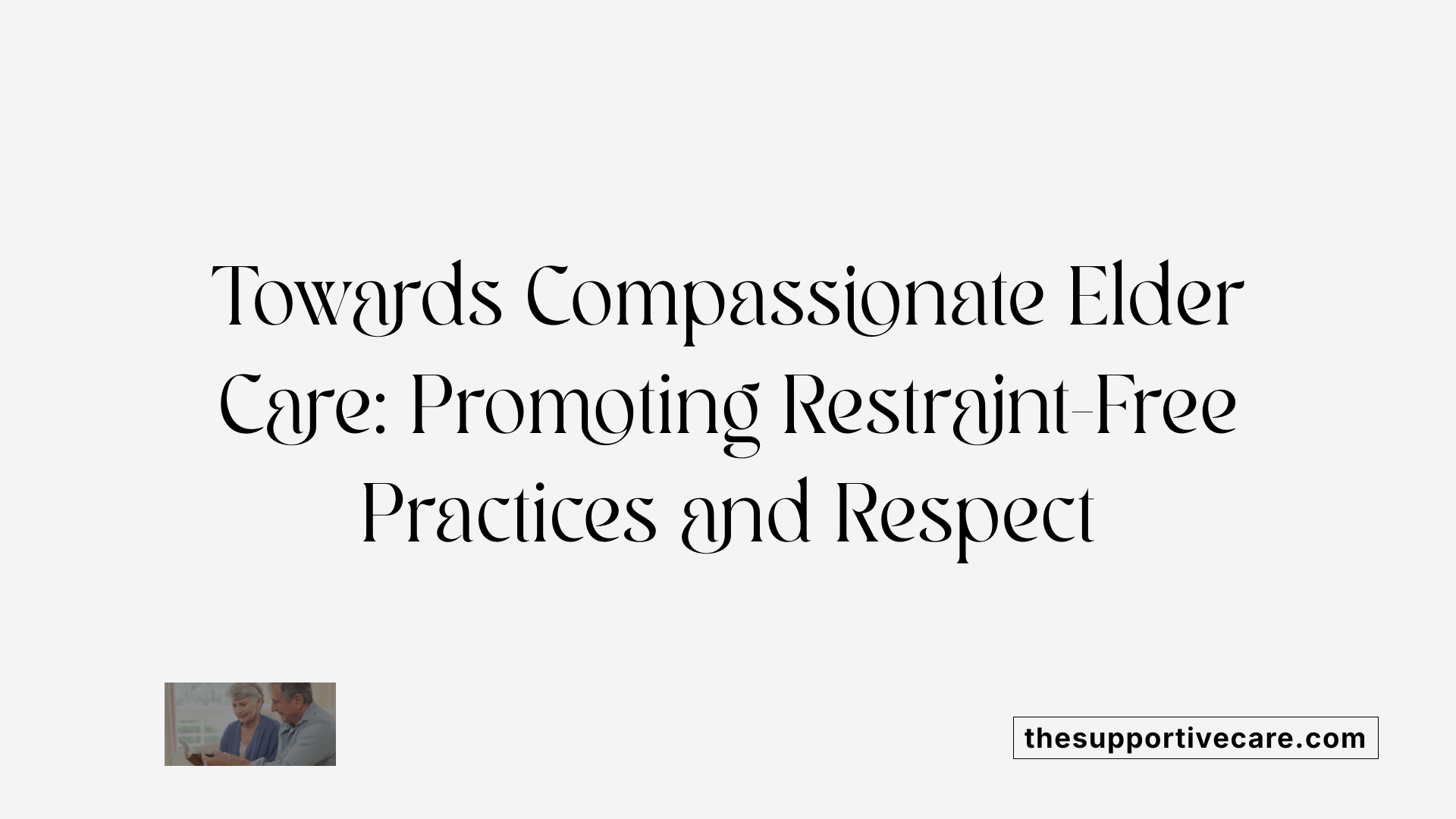
Promoting dignity through alternative approaches
Reducing or eliminating physical restraints in elder care is essential to uphold the dignity and autonomy of older adults. Implementing person-centered strategies, such as environmental modifications, personalized care plans, and enhanced communication techniques, helps address behavioral issues without resorting to restraints. Training caregivers to recognize unmet needs and employ non-restrictive interventions has proven effective. For instance, activities that engage residents or family participation can significantly decrease the perceived need for physical restrictions.
Organizational and policy reforms
Successfully phasing out restraints requires robust organizational policies supported by management and interdisciplinary teams. Policies should emphasize restraint as a last resort, with clear guidelines on assessment, alternatives, and ongoing monitoring. Regular staff training and education are crucial to shift the culture towards restraint-free care. Establishing restraint reduction committees and continuous quality improvement initiatives foster accountability and ensure best practices. Legislation further supports these efforts by mandating informed consent, periodic review, and safeguarding patient rights. Together, these reforms guide healthcare providers in delivering safer, more compassionate elder care, emphasizing respect and holistic wellbeing.
Prioritizing Dignity and Safety: The Way Forward in Elder Care
Transitioning towards restraint-free models demands organizational commitment, staff education, and innovative care strategies that uphold elderly residents’ dignity and psychological well-being. By fostering a culture of respect and implementing person-centered, trauma-informed practices, elder care environments can reduce reliance on restraints—ultimately ensuring safer, more humane, and holistic care for our aging population.
References
- Use of physical restraint in nursing homes: clinical‐ethical ...
- Avoiding Restraints in Patients with Dementia | HIGN
- Use of Physical Restraints in the Emergency Department
- Physical and Pharmacological Restraints in Hospital Care - Frontiers
- Reducing Physical Restraints in Nursing Homes - ScienceDirect.com
- Reducing physical restraints by older adults in home care
- Physical restraints among the elderly in the acute care setting



































































































